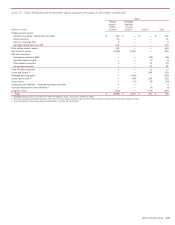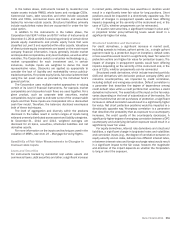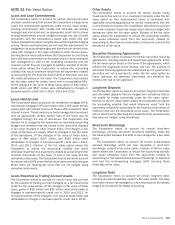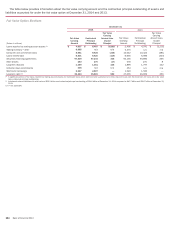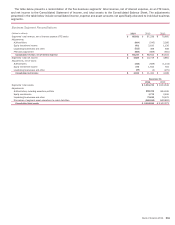Bank of America 2014 Annual Report Download - page 255
Download and view the complete annual report
Please find page 255 of the 2014 Bank of America annual report below. You can navigate through the pages in the report by either clicking on the pages listed below, or by using the keyword search tool below to find specific information within the annual report.Bank of America 2014 253
NOTE 21 Fair Value Option
Loans and Loan Commitments
The Corporation elects to account for certain commercial loans
and loan commitments that exceed the Corporation’s single name
credit risk concentration guidelines under the fair value option.
Lending commitments, both funded and unfunded, are actively
managed and monitored and, as appropriate, credit risk for these
lending relationships may be mitigated through the use of credit
derivatives, with the Corporation’s public side credit view and
market perspectives determining the size and timing of the hedging
activity. These credit derivatives do not meet the requirements for
designation as accounting hedges and therefore are carried at fair
value with changes in fair value recorded in other income (loss).
Electing the fair value option allows the Corporation to carry these
loans and loan commitments at fair value, which is more consistent
with management’s view of the underlying economics and the
manner in which they are managed. In addition, election of the fair
value option allows the Corporation to reduce the accounting
volatility that would otherwise result from the asymmetry created
by accounting for the financial instruments at historical cost and
the credit derivatives at fair value. The Corporation also elected
the fair value option for certain loans held in consolidated VIEs.
Of the changes in fair value of these loans, gains of $32 million,
$148 million and $527 million were attributable to changes in
borrower-specific credit risk in 2014, 2013 and 2012.
Loans Held-for-sale
The Corporation elects to account for residential mortgage LHFS,
commercial mortgage LHFS and certain other LHFS under the fair
value option with interest income on these LHFS recorded in other
interest income. These loans are actively managed and monitored
and, as appropriate, certain market risks of the loans may be
mitigated through the use of derivatives. The Corporation has
elected not to designate the derivatives as qualifying accounting
hedges and therefore they are carried at fair value with changes
in fair value recorded in other income (loss). The changes in fair
value of the loans are largely offset by changes in the fair value
of the derivatives. Of the changes in fair value of these loans,
gains of $84 million, $225 million and $425 million were
attributable to changes in borrower-specific credit risk in 2014,
2013 and 2012. Election of the fair value option allows the
Corporation to reduce the accounting volatility that would
otherwise result from the asymmetry created by accounting for the
financial instruments at the lower of cost or fair value and the
derivatives at fair value. The Corporation has not elected to account
for certain other LHFS under the fair value option primarily because
these loans are floating-rate loans that are not hedged using
derivative instruments.
Loans Reported as Trading Account Assets
The Corporation elects to account for certain loans that are held
for the purpose of trading and risk-managed on a fair value basis
under the fair value option. Of the changes in fair value of these
loans, gains of $28 million and $56 million were attributable to
changes in borrower-specific credit risk in 2014 and 2013. An
immaterial portion of the changes in fair value of these loans was
attributable to changes in borrower-specific credit risk in 2012.
Other Assets
The Corporation elects to account for certain private equity
investments that are not in an investment company under the fair
value option as this measurement basis is consistent with
applicable accounting guidance for similar investments that are
in an investment company. The Corporation also elects to account
for certain long-term fixed-rate margin loans that are hedged with
derivatives under the fair value option. Election of the fair value
option allows the Corporation to reduce the accounting volatility
that would otherwise result from the asymmetry created by
accounting for the financial instruments at historical cost and the
derivatives at fair value.
Securities Financing Agreements
The Corporation elects to account for certain securities financing
agreements, including resale and repurchase agreements, under
the fair value option based on the tenor of the agreements, which
reflects the magnitude of the interest rate risk. The majority of
securities financing agreements collateralized by U.S. government
securities are not accounted for under the fair value option as
these contracts are generally short-dated and therefore the
interest rate risk is not significant.
Long-term Deposits
The Corporation elects to account for certain long-term fixed-rate
and rate-linked deposits that are hedged with derivatives that do
not qualify for hedge accounting under the fair value option.
Election of the fair value option allows the Corporation to reduce
the accounting volatility that would otherwise result from the
asymmetry created by accounting for the financial instruments at
historical cost and the derivatives at fair value. The Corporation
did not elect to carry other long-term deposits at fair value because
they were not hedged using derivatives.
Short-term Borrowings
The Corporation elects to account for certain short-term
borrowings, primarily short-term structured liabilities, under the
fair value option because this debt is risk-managed on a fair value
basis.
The Corporation elects to account for certain asset-backed
secured financings, which are also classified in short-term
borrowings, under the fair value option. Election of the fair value
option allows the Corporation to reduce the accounting volatility
that would otherwise result from the asymmetry created by
accounting for the asset-backed secured financings at historical
cost and the corresponding mortgage LHFS securing these
financings at fair value.
Long-term Debt
The Corporation elects to account for certain long-term debt,
primarily structured liabilities, under the fair value option. This long-
term debt is either risk-managed on a fair value basis or the related
hedges do not qualify for hedge accounting.






